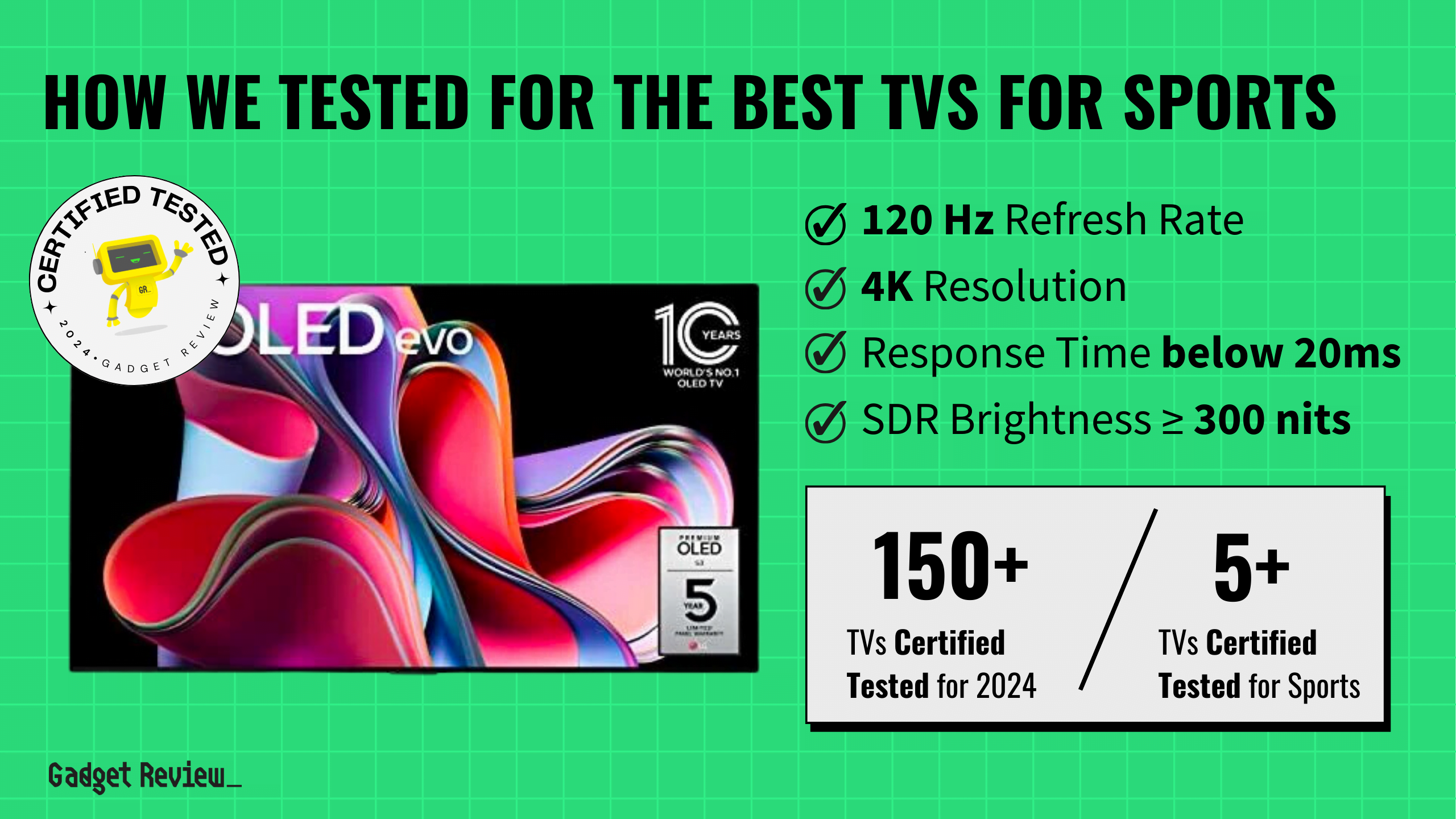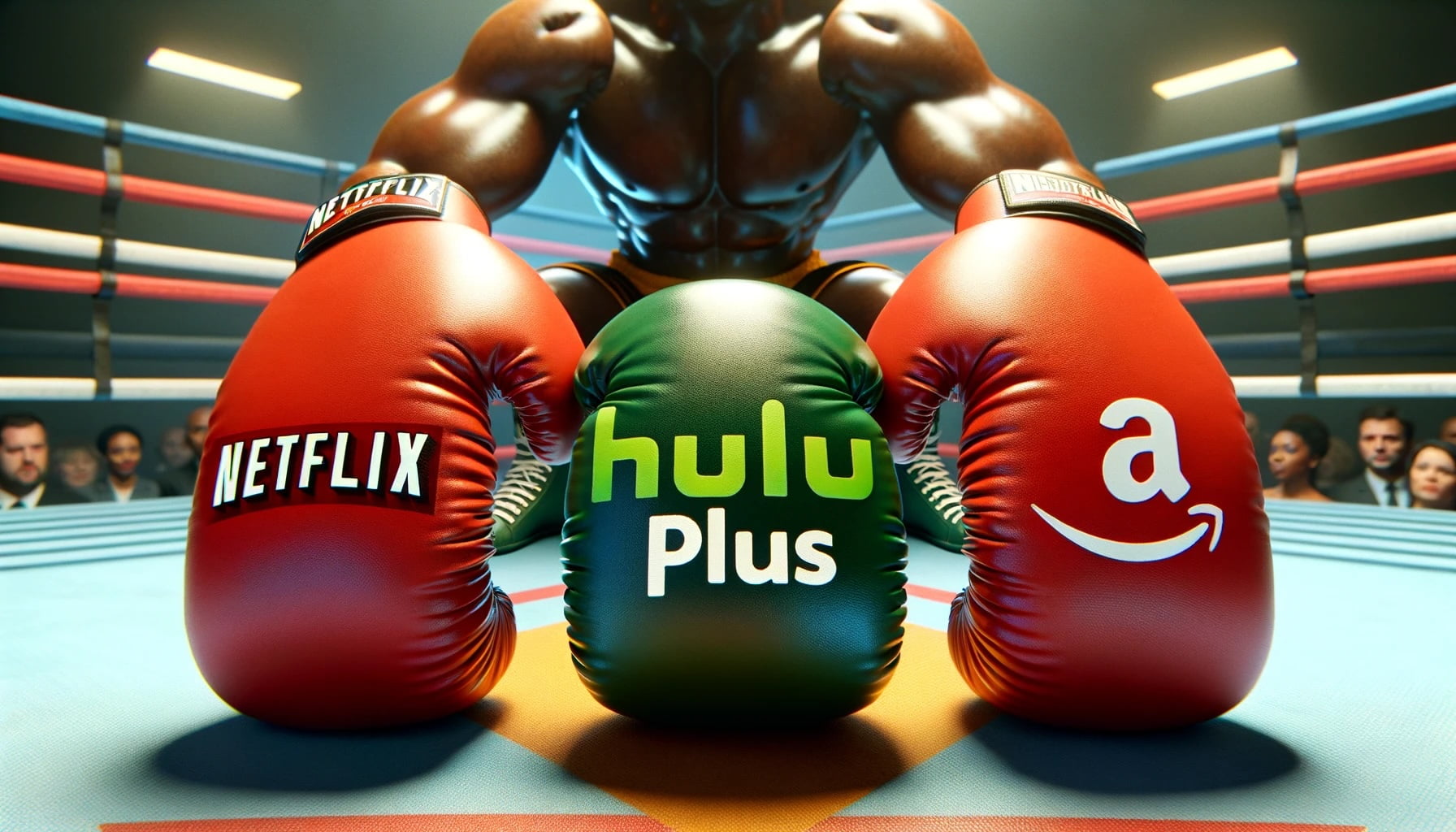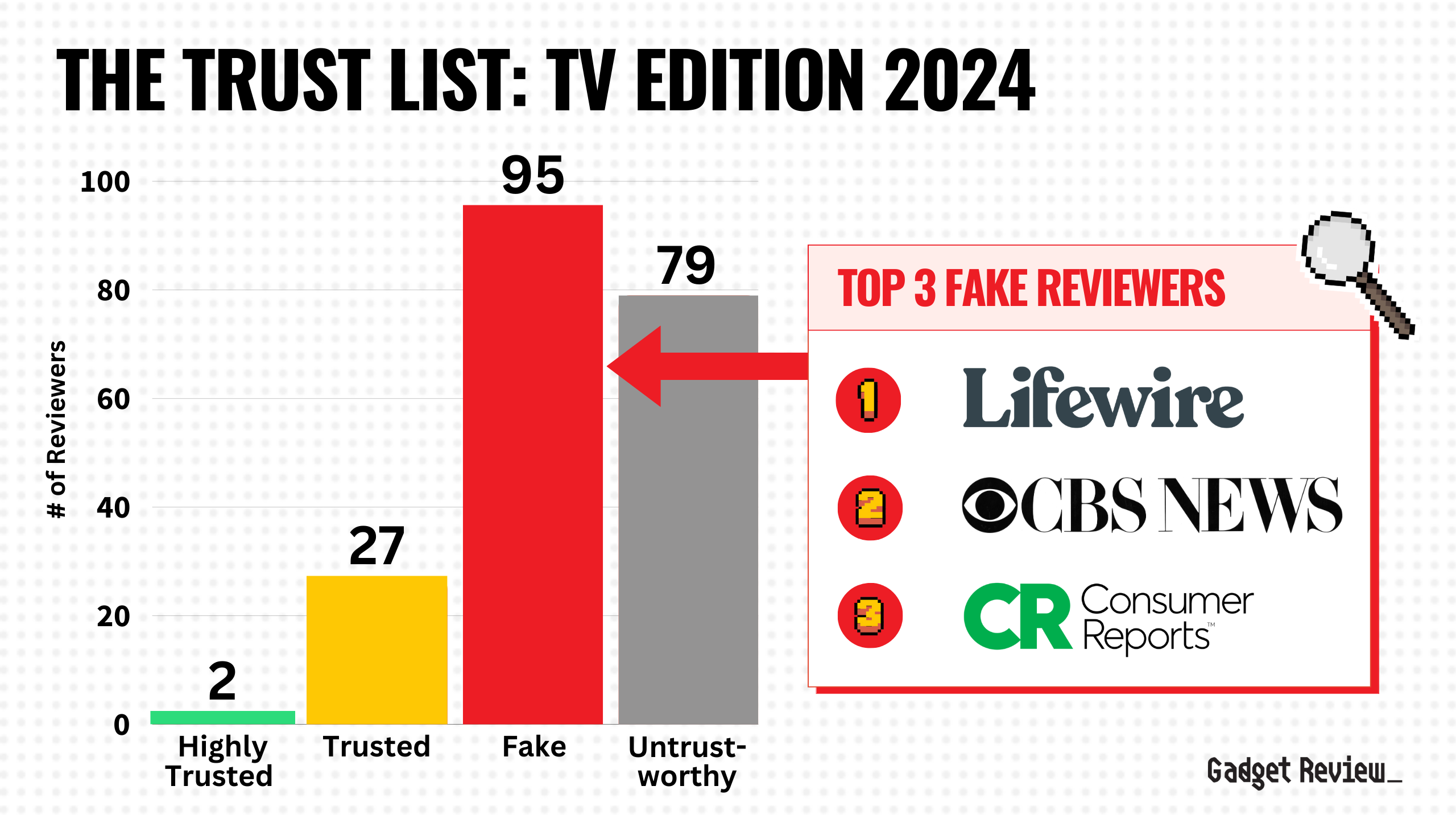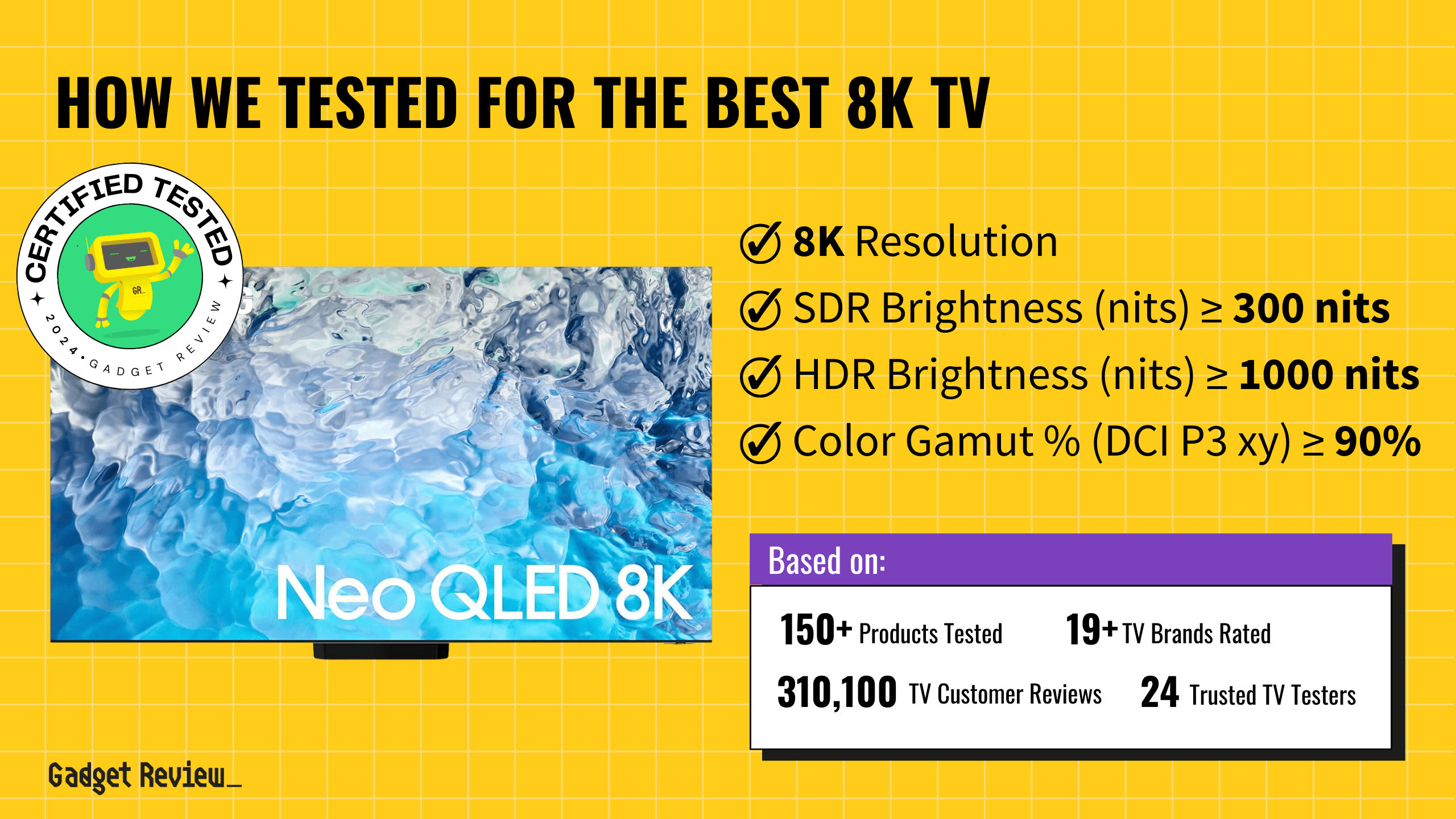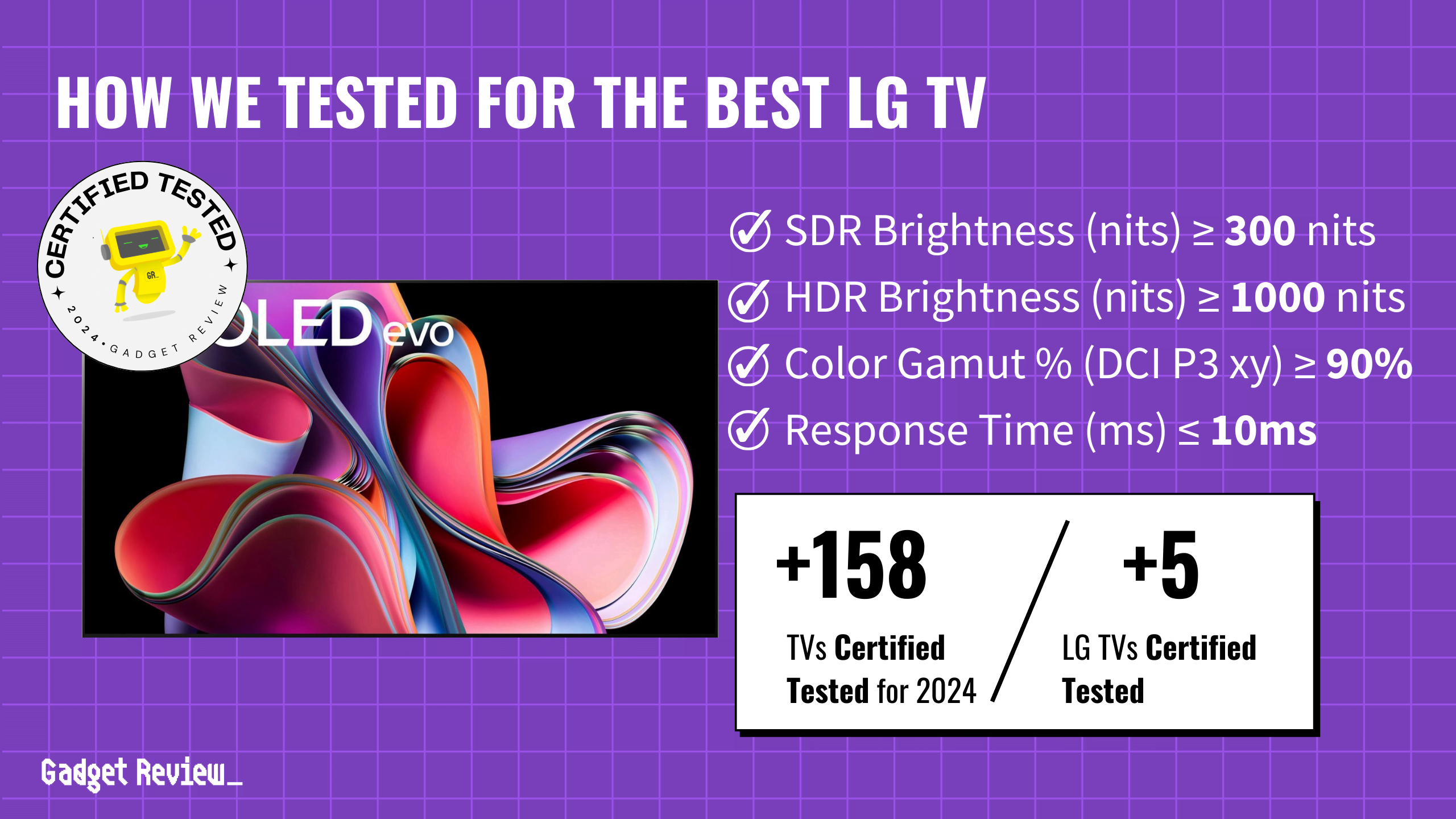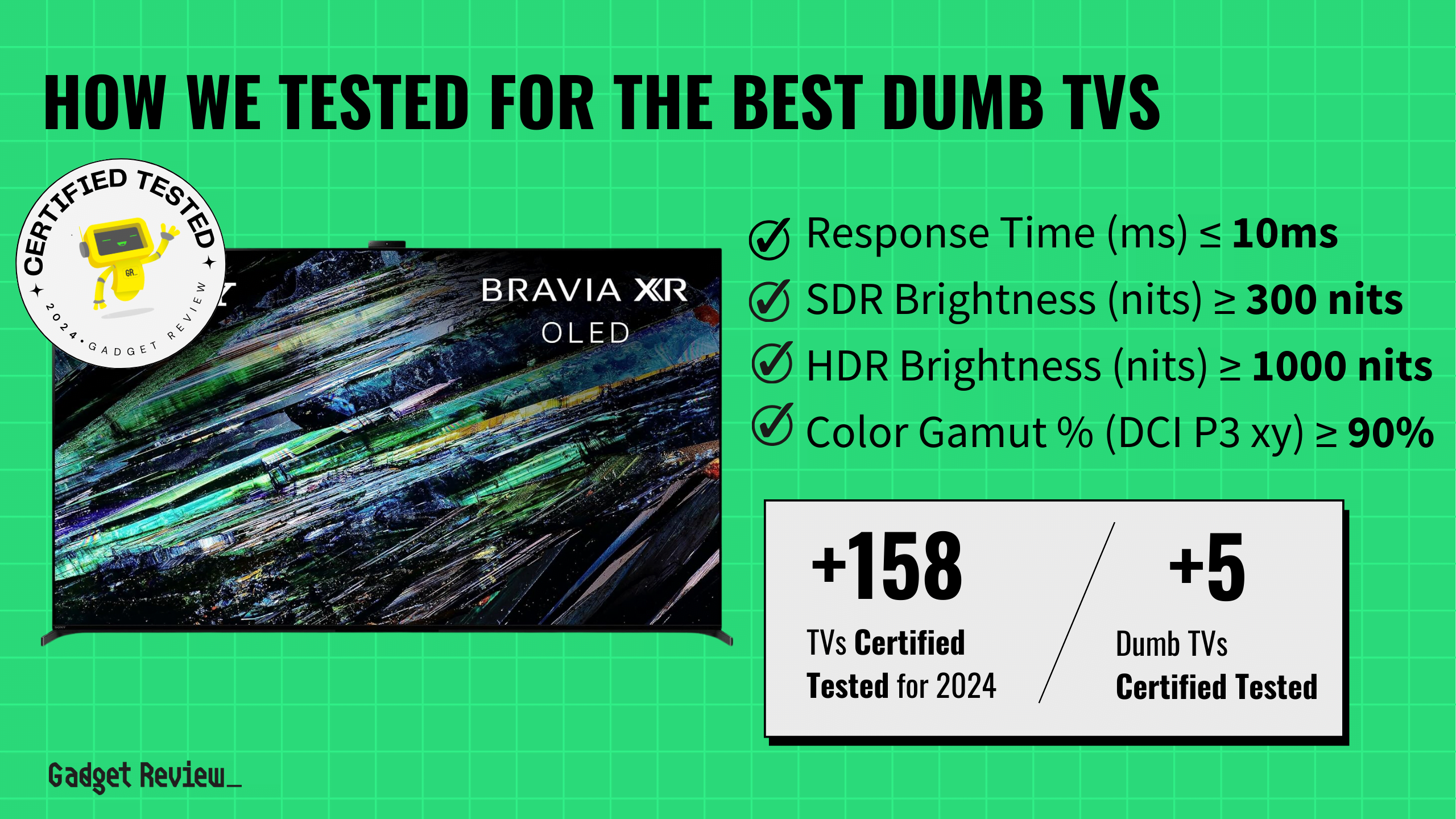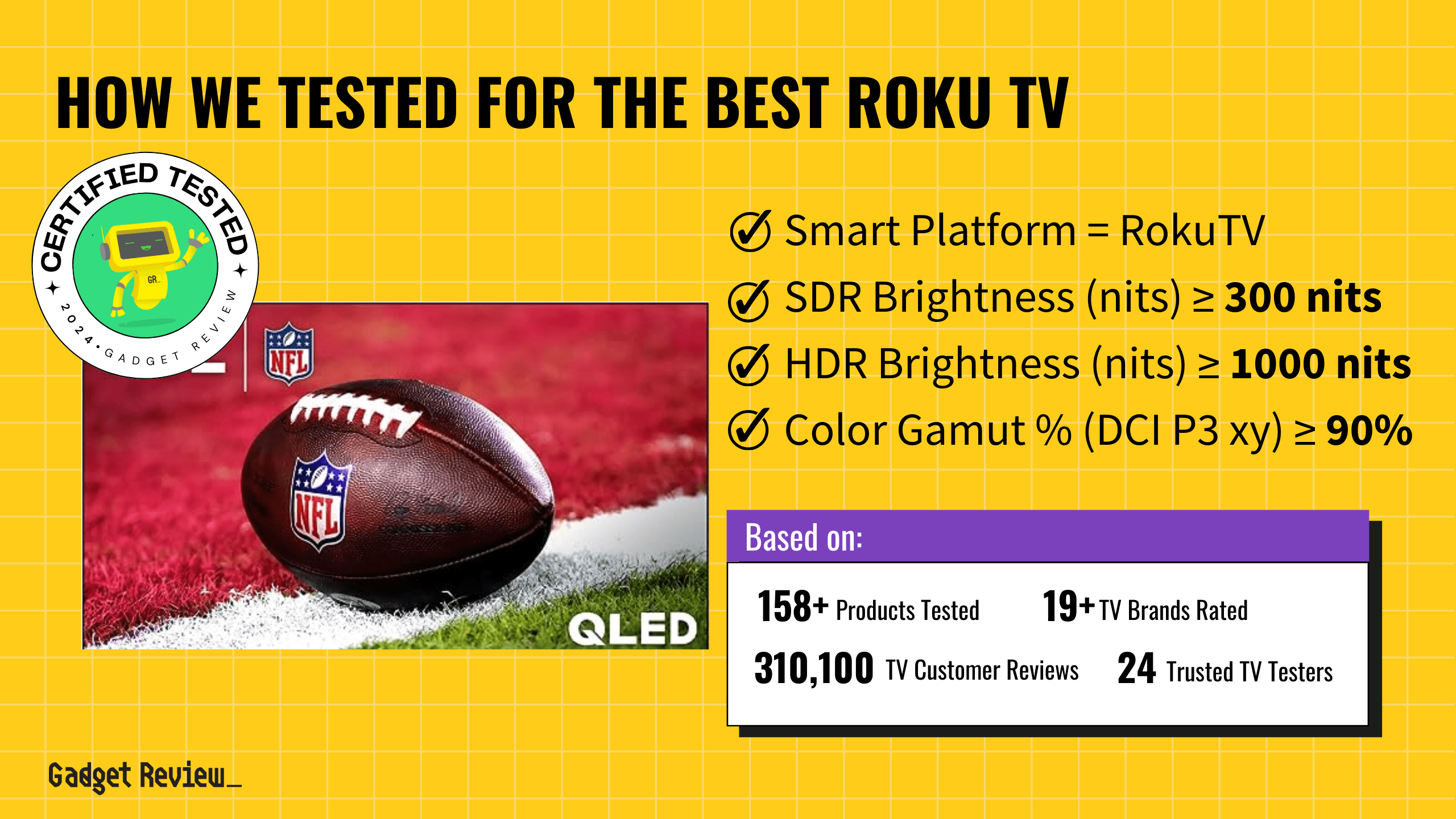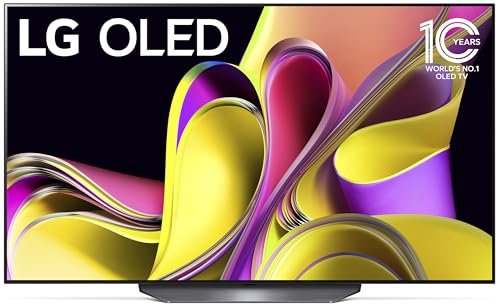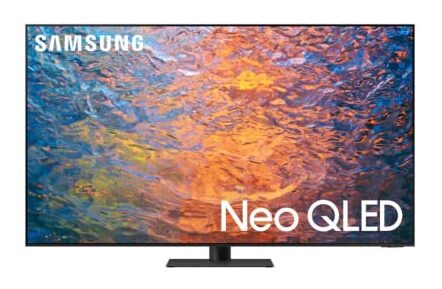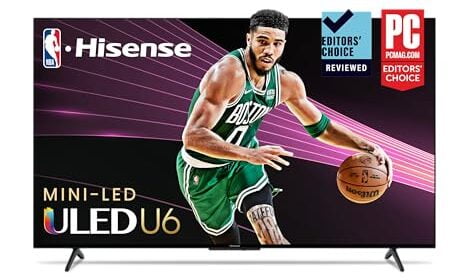If you’re looking for the best sports TV, then you want to read product reviews by actual experts who have tested several TVs for sports in all price ranges – not fake reviews pushing you to purchase a TV that will crap out on the big game. That’s why we scour the web and certify 158 TVs as fully tested and then shortlist the best sports TVs to ensure you’re ready for game day (BTW, we were shocked to find 87% of TV reviewers aren’t trustworthy and many are faking their reviews).
The best TVs for sports have four essential features that are non-negotiable: lightning-quick response times to keep every action crisp and clear, eliminating any ghosting or blurs; wide viewing angles ensuring everyone gets a great view, no matter where they’re sitting; superior reflection handling and the right levels of brightness (both SDR and HDR) to keep the game visible in any light.
These features aren’t just nice to have; they’re the pillars of an immersive sports viewing experience, critical for anyone serious about their sports and tech. Plus, all our recommended top TV models come in sizes 55″ and up, perfect for large gatherings (on Super Bowl Sunday or any sporting event) without compromising on visual quality or performance.
How Did We Rank the Best TVs for Sports?
To assess how high or low quality a TV actually is for sports viewing, one must evaluate specific testing criteria against reference industry standards. Using our thorough TV Testing Methodology, we determined there are 2 minimum specs and 6 criteria below (3 required, 3 nice to have) that ensure your sports come alive and immerse you on game day.
?️
Minimum Specifications
- Refresh Rate: Minimum 120 Hz to eliminate motion blur, capturing the swift movements of sports effortlessly.
- Resolution: 4K for that ultra-clear, lifelike detail that brings the game to life.
?
Test Criteria
- Response Time: A TV’s response time needs to hit at least 10ms or less to ensure the action never blurs and no moment is ever lost.
- SDR Brightness: SDR brightness needs to hit at least 300 nits to ensure the screen pops even in bright rooms.
- HDR Brightness: HDR brightness must meet a minimum of at least 700 nits, highlighting every detail from the brightest brights to the darkest darks, regardless of lighting conditions.
?
“Nice To Haves”
- Reflectivity: Less than 4.5% reflectivity, because nothing should take away from those game-changing moments.
- Color Gamut: Aiming for 97% DCI P3 xy or higher, to ensure a TV is bringing the most realistic colors to your screen, enhancing every match’s realism.
- Viewing Angle: Greater than 45 degrees to ensure the picture stays perfect, without any color fading, even from the side.
Keep reading to discover the top TV for sports. We’ve got options for the budget conscious, the value driven shopper, the home theater buff, the competitive gamer and for rooms that have an almost unmanageable amounts of direct or indirect light.
We’ve redefined TV buying guides, setting us apart from any other site on the planet. Our unique approach combines in-house verification with a comprehensive dataset from over 200+ trusted sites, focusing on key testing metrics like response time, reflections, brightness, and viewing angle. We aggregate and analyze data from 158+ TVs, ensuring our recommendations meet your specific needs. In this case its for sports viewing, which means reducing or eliminating motion blur and reflections, overcoming bright lights and all the while providing wide audience viewing. Discover our data-driven methodology for precise, reliable TV recommendations.
Latest Updates
- 02/1/2024: Completely and thoroughly overhauled the guide to include the best and latest TVs for sports.
- 11/21/2023: Republished the list to include TVs based on our True Score system.
Our commitment to unbiased reviews is powered by our ‘True Score’ system, targeting low quality and fake reviews. Commissions fund this mission. No bias. No BS. Learn more
Top Sports TVs For 2025
Prices accurate at the time of publishing
Any TV that wants a chance at being considered needs to have a refresh rate of at least 120 Hz and a minimum resolution of 4K. If it doesn’t make the cutoff, you won’t find it on our list!

Best Overall

Runner Up

Best Value

Best Budget

Best Mid-Range

Premium Pick
Samsung S90C TV
Best For 55-inch
The Samsung S90C excels with its unparalleled color accuracy and swift response, offering a versatile, high-quality viewing experience for sports, gaming, and more.
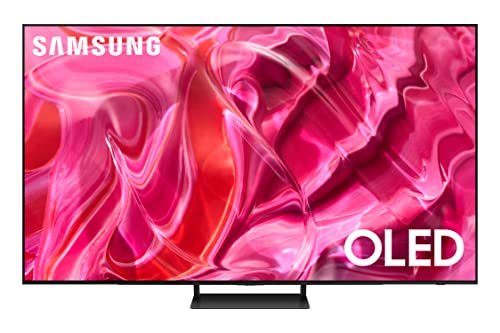
True Score
92948Experts
925kCustomers
Cosmic Wonder
 SAVE $500$1,499.99$999.99
SAVE $500$1,499.99$999.99Snapshot
Reasons to Buy
- Excellent picture quality
- The near-infinite contrast ratio for perfect blacks
- High peak brightness
- Exceptionally wide viewing angle
- Low input lag/Response time
- Sharp upscaling
Reasons to Avoid
- Aggressive Auto Brightness Limiter (ABL)
- No support for DTS or Dolby Vision
Specifications
Refresh Rate 120 Hz, 144 Hz Max Resolution 3840 x 2160 (4k) Screen size 55″, 65″, 75″, 83″ 
Backlight Type n/a Display Type OLED HDMI Inputs 4 
HDMI Type HDMI 2.1 HDR Format HDR10+, HLG 
HomeKit Compatible No 
Number of Audio Channels 2.1 
Panel Type OLED 
Smart Platform Tizen 
Speaker Output 40 Watts 
Sync Technology AMD FreeSync Premium 
VRR Yes All Specs
Test Results
Response Time (ms) 1.4 SDR Brightness (nits) 373 HDR Brightness (nits) 1,058 Reflections (%) 1.2 Color Gamut % (DCI P3 xy) 99.975 Color Washout (Degrees) 70 Color Gamut % (DCI P3 uv) 99.95 Color Gamut % (Rec 2020 xy) 86.37 Color Gamut % (Rec 2020 uv) 91.59 Color Gamut % (sRGB) 0 Color Gamut % (Rec 709) 0 Color Gamut % (BT.2020) 76 Color Gamut % (Adobe RGB) 0 Color Gamut % (BT.709) 0 Contrast Ratio (x:1) 0 Input Lag (ms) 8.5 Color Shift (Degrees) 70 Brightness Loss (Degrees) 70 Low-Freq Extension (Hz) 84.76 Freq Response StdDev @ 70db 2.8 Freq Response StdDev @ 80db 3.63 Weighted Total Harmonic Distortion @80db 0.133 Intermodulation Distortion @80db 2.47 EOTF (600 nit delta) 0.0031 EOTF (1000 nit delta) 0.0036 EOTF (4000 nit delta) 0.0024 All Tests
All Retailers
- $999.99$1,500Save $500
- $1,345.95
- $1,449.00$2,598Save $1,149
Our Verdict
The Samsung S90C, our runner-up sports TV, makes every game a visual feast. Notably, its color gamut reaches an astounding 99.975%, best in class, ensuring the greens of the field and the team colors pop with unparalleled vibrancy. This, combined with a superb 70-degree color washout, means that viewers can enjoy a consistent, rich viewing experience from almost any angle in the room, crucial for group sports watching.
Although its SDR brightness at 373 nits and HDR brightness at 1058 nits are not the highest, the quality of the Samsung S90C’s display, enhanced by HDR10+ support, compensates by delivering detailed and dynamic images, bringing the intensity of live sports into your living space. The TV also excels in minimizing reflections (1.2%), a critical feature for those afternoon matches in well-lit rooms.
With an impressively low input lag of 8.5 ms and a quick response time of 1.4 ms, the Samsung S90C TV not only beats out the LG G3 in response time, making it best in class, but also comes in as a significantly cheaper option. This combination also makes it particularly attractive for gamers, ensuring that the action remains fluid without any distracting delay or motion blur.
Combine this excellent performance with the Tizen OS onboard and stream sports directly to your television – no streaming box needed! The Samsung S90C TV is also much more than just a sports TV; it’s an all-around performer suited for various entertainment needs. Whether it’s watching sports, gaming or enjoying movies in a home theater setup, Samsung S90C delivers on all fronts, making every viewing experience memorable.

Best Overall

Runner Up

Best Value

Best Budget

Best Mid-Range

Premium Pick
LG G3 OLED TV
Best For 80-inch
The LG G3 OLED TV excels in sports viewing with top-notch HDR, wide viewing angles, and Dolby Vision, making it an ideal choice as a versatile home theater centerpiece.
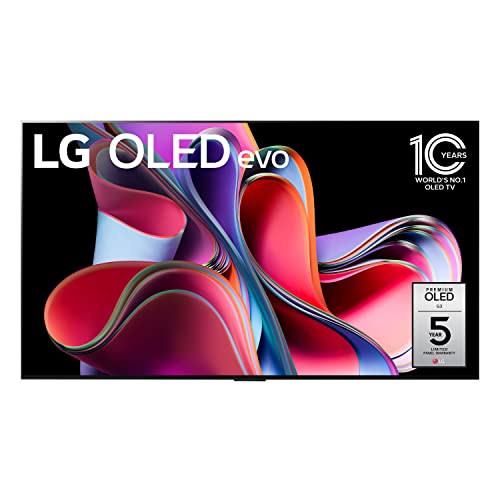
True Score
919315Experts
913kCustomers
Cosmic Wonder
 SAVE $1$3,296.99$1,996.99
SAVE $1$3,296.99$1,996.99Snapshot
Reasons to Buy
- Excellent picture quality
- Near-infinite contrast ratio resulting in perfect blacks
- Extremely bright for an OLED
- Fast motion handling
- Exceptionally wide viewing angle
Reasons to Avoid
- Aggressive automatic brightness limiter
- Subpar sound quality
Specifications
Refresh Rate 120 Hz Max Resolution 3840 x 2160 (4k) Screen size 55″, 65″, 77″, 83″ 
Backlight Type n/a Display Type OLED HDMI Inputs 4 
HDMI Type HDMI 2.1 HDR Format Dolby Vision, HDR10, HLG 
HomeKit Compatible Yes 
Number of Audio Channels 4.2 
Panel Type OLED 
Smart Platform webOS 
Speaker Output 60 watts 
Sync Technology G-Sync 
VRR Yes All Specs
Test Results
Response Time (ms) 2.6 SDR Brightness (nits) 503 HDR Brightness (nits) 1,385 Reflections (%) 0.9 Color Gamut % (DCI P3 xy) 97.5457 Color Washout (Degrees) 70 Color Gamut % (DCI P3 uv) 99.13 Color Gamut % (Rec 2020 xy) 73.65 Color Gamut % (Rec 2020 uv) 75.48 Color Gamut % (sRGB) 100 Color Gamut % (Rec 709) 99.7631 Color Gamut % (BT.2020) 74.4 Color Gamut % (Adobe RGB) 94 Color Gamut % (BT.709) 0 Contrast Ratio (x:1) 0 Input Lag (ms) 11.8 Color Shift (Degrees) 70 Brightness Loss (Degrees) 70 Low-Freq Extension (Hz) 89.8 Freq Response StdDev @ 70db 2.01 Freq Response StdDev @ 80db 2 Weighted Total Harmonic Distortion @80db 0.143 Intermodulation Distortion @80db 1.4 EOTF (600 nit delta) 0.0027 EOTF (1000 nit delta) 0.0039 EOTF (4000 nit delta) 0.0036 All Tests
All Retailers
- $1,996.99$3,297Save $1
- $2,316.92$2,797Save $480
- $2,899.00$3,300Save $401
Our Verdict
For sports enthusiasts demanding crisp, lifelike action, the LG G3 OLED TV leads the pack, offering unparalleled viewing experiences right from the comfort of your couch. Its SDR and HDR brightness levels stand out, with the HDR brightness peaking at an impressive 1385 nits, best in class for OLED panels on our list, ensuring that every play is illuminated with clarity and detail, whether you’re watching a daytime game or a night match. The swift 2.6 ms response time means you won’t miss a beat, capturing every fast move with zero blur, making it the go-to TV for action-packed sports.
The LG G3 also excels in creating an immersive viewing environment, with remarkable reflections handling of just 0.9% and a vibrant color gamut coverage of 97.54%. These features work together to produce vibrant, true-to-life colors and maintain image quality under various lighting conditions, ensuring you’re as close to the stadium feel as possible.
Its 70-degree viewing angle also means that no one will miss a play no matter where they sit at the next game day party, especially if you opt for the 83″ size variant. Plus, with Dolby Vision HDR support, the LG G3 takes the viewing experience up a notch, offering stunning contrast and brightness that bring every moment to life with breathtaking detail. Pair this with the built in webOS and stream sports directly to your TV without ever picking up a streaming box.
Positioned at the top of our list, the LG G3 OLED TV isn’t just about sports – it’s got good enough HDR brightness to be used in bright rooms, though it will suffer a bit when showing off SDR content. The best-in-class EOTF means that the G3 is also a phenomenal choice for anyone looking to pick up their home theater centerpiece.

Best Overall

Runner Up

Best Value

Best Budget

Best Mid-Range

Premium Pick
Samsung S95C OLED TV
Best For Best Overall
The S95C excels in brightly lit rooms with high SDR brightness and color accuracy, making it ideal for sports, gaming and home theater content.
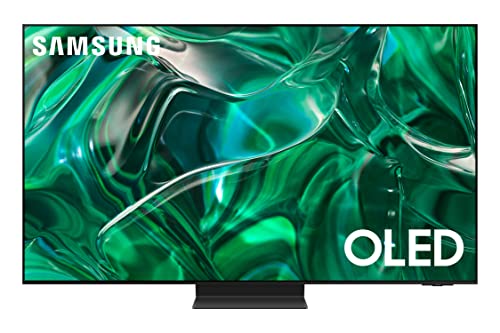
True Score
899215Experts
90721Customers
Absolutely Fresh
 SAVE $400$2,299.99$1,899.99
SAVE $400$2,299.99$1,899.99Snapshot
Reasons to Buy
- Excellent image quality
- Produces great bright colors and deep blacks
- Exceptionally wide viewing angle
- Incredibly low input lag
Reasons to Avoid
- Aggressive ABL
Specifications
Refresh Rate 120 Hz, 144 Hz Max Resolution 3840 x 2160 (4k) Screen size 55″, 65″, 77″ 
Backlight Type No Display Type OLED HDMI Inputs 4 
HDMI Type HDMI 2.1 HDR Format HDR10+, HLG 
HomeKit Compatible No 
Number of Audio Channels 4.2.2 
Panel Type QD-OLED 
Smart Platform Tizen 
Speaker Output 70 Watts 
Sync Technology AMD FreeSync, AMD FreeSync Premium Pro 
VRR Yes All Specs
Test Results
Response Time (ms) 5.5 SDR Brightness (nits) 704 HDR Brightness (nits) 1,383 Reflections (%) 1 Color Gamut % (DCI P3 xy) 99.81 Color Washout (Degrees) 70 Color Gamut % (DCI P3 uv) 99.53 Color Gamut % (Rec 2020 xy) 84.99 Color Gamut % (Rec 2020 uv) 89.78 Color Gamut % (sRGB) 0 Color Gamut % (Rec 709) 141.5 Color Gamut % (BT.2020) 75 Color Gamut % (Adobe RGB) 0 Color Gamut % (BT.709) 0 Contrast Ratio (x:1) 0 Input Lag (ms) 8.3 Color Shift (Degrees) 70 Brightness Loss (Degrees) 70 Low-Freq Extension (Hz) 106.79 Freq Response StdDev @ 70db 2.45 Freq Response StdDev @ 80db 2.41 Weighted Total Harmonic Distortion @80db 0.511 Intermodulation Distortion @80db 0.511 EOTF (600 nit delta) 0.0029 EOTF (1000 nit delta) 0.0025 EOTF (4000 nit delta) 0.0022 All Tests
All Retailers
- $1,899.99$2,300Save $400
- $2,397.95
Our Verdict
If you’re loyal to the Samsung brand and seeking the same top-tier performance of the G3, you might want to consider the S95C. With its HDR brightness peaking at 1383 nits and SDR performance at 704 nits, the S95C beats the G3 in SDR brightness by over 200 nits and loses in HDR by only 2, giving the S95C the edge when it comes to watching sports in brightly lit rooms. Its impressive 99.81% color gamut and wide 70-degree viewing angle also mean that no matter where you’re seated, you’re guaranteed a good view of the game.
While the S95C lags behind the G3 in response time, 5.5 ms is still attractive enough for gamers and sports fans alike, particularly the former thanks to its 8.3 ms input lag. These results make for fluid, blur-free action scenes in any content. No support for Dolby Vision is a letdown, but its EOTF performance at 0.0029 showcases the TV’s ability to render HDR luminance with precision – excellent for those seeking a cinematic home theater experience if they’re willing to compromise on only using HDR10+.
With its blend of high-end features that cater to a variety of entertainment needs, the S95C delivers a compelling visual experience that Samsung enthusiasts will appreciate when watching sports, enjoying movies or playing games.

Best Overall

Runner Up

Best Value

Best Budget

Best Mid-Range

Premium Pick
LG C3 OLED TV
Best For 50-inch
The LG C3 OLED offers premium LG quality for sports, gaming, and movies with excellent color accuracy and quick response, all at a more accessible price point.
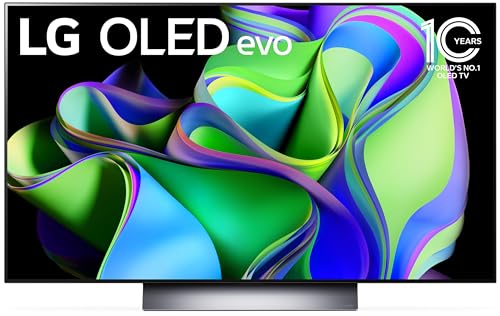
True Score
88879Experts
9312kCustomers
Absolutely Fresh
 SAVE $300$1,599.99$1,299.99
SAVE $300$1,599.99$1,299.99Snapshot
Reasons to Buy
- Excellent picture quality
- The near-infinite contrast ratio for perfect blacks
- Strong peak brightness
- High-performance motion handling
- Fast refresh rate
Reasons to Avoid
- Aggressive automatic brightness limiter
- Subpar sound quality
Specifications
Refresh Rate 120 Hz Max Resolution 3840 x 2160 (4k) Screen size 42″, 48″, 55″, 65″, 75″, 83″ 
Backlight Type No Display Type OLED HDMI Inputs 4 
HDMI Type HDMI 2.1 HDR Format Dolby Vision, HDR10, HLG 
HomeKit Compatible Yes 
LED Panel Type WOLED 
Number of Audio Channels 7.1.2 
Panel Type – 
Smart Platform webOS 
Speaker Output 20 Watts 
Sync Technology AMD FreeSync Premium, G-Sync 
VRR Yes All Specs
Test Results
Response Time (ms) 2.3 SDR Brightness (nits) 383 HDR Brightness (nits) 795 Reflections (%) 1.1 Color Gamut % (DCI P3 xy) 98.98 Color Washout (Degrees) 63 Color Gamut % (DCI P3 uv) 99.51 Color Gamut % (Rec 2020 xy) 73.28 Color Gamut % (Rec 2020 uv) 76.01 Color Gamut % (sRGB) 0 Color Gamut % (Rec 709) 0 Color Gamut % (BT.2020) 74.7 Color Gamut % (Adobe RGB) 0 Color Gamut % (BT.709) 0 Contrast Ratio (x:1) 0 Input Lag (ms) 9.6 Color Shift (Degrees) 34 Brightness Loss (Degrees) 70 Low-Freq Extension (Hz) 80 Freq Response StdDev @ 70db 1.14 Freq Response StdDev @ 80db 1.98 Weighted Total Harmonic Distortion @80db 0.085 Intermodulation Distortion @80db 4.49 EOTF (600 nit delta) 0.0056 EOTF (1000 nit delta) 0.0054 EOTF (4000 nit delta) 0.0051 All Tests
All Retailers
- $1,299.99$1,600Save $300
- $1,396.99$1,500Save $103
- $1,396.99$2,500Save $1,103
- $1,596.99$2,497Save $900
Our Verdict
For those that are looking for LG’s top quality panels without paying top dollar, the LG C3 OLED TV is an attractive mid-range alternative to the G3. While it comes in fifth on our list, the LG C3 delivers on the essential fronts for sports watching: it features an SDR brightness of 383 nits and HDR brightness of 795 nits, ensuring vivid and bright imagery across various lighting conditions. Its color fidelity is also impressive, with a 98.98% color gamut, bringing the vibrant colors of the game to life with accuracy and depth.
Thanks to a response time of just 2.3 ms, the LG C3 is adept at handling the fast-paced action of sports, keeping you in the heart of the action. Additionally, the LG C3’s support for Dolby Vision HDR offers an enhanced depth and realism to HDR content, which is particularly noticeable in the dynamic lighting of live sports broadcasts and adds an extra layer of immersion to your home theater setup.
The input lag of 9.6 ms also makes the C3 an excellent choice for gamers looking for a strong performer that doesn’t over-stretch budgets but still is capable of delivering premium LG performance. The quick response time and high color accuracy also make the set good for movie watching, making the C3 a comprehensive entertainment solution.

Best Overall

Runner Up

Best Value

Best Budget

Best Mid-Range

Premium Pick
TCL QM8/QM850G QLED TV
Best For Android
The TCL QM8/QM850G shines in brightness and value, perfect for sports in bright rooms, with notable compromises in contrast and viewing angles.
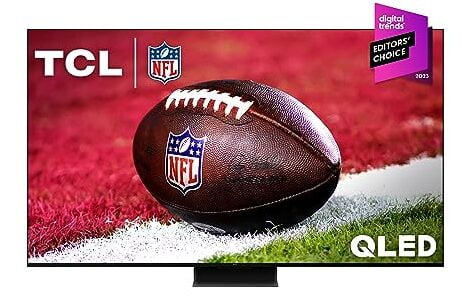
True Score
86847Experts
89560Customers
Absolutely Fresh
 SAVE $50$999.99$949.99
SAVE $50$999.99$949.99Snapshot
Reasons to Buy
- Outstanding picture quality
- Spectacular brightness and contrast ratio
- Rapid response time
- Super low input lag
Reasons to Avoid
- Disappointing viewing angles
Specifications
Refresh Rate 120 Hz Max Resolution 3840 x 2160 (4k) Screen size 65″, 75″, 85″, 98″ 
Backlight Type Full-Array 
Depth 11.7″ Display Type QLED HDMI Inputs (Total) 2 
HDMI Type HDMI 2.1 HDR Format Dolby Vision, HDR10, HDR10+, HLG 
Height 34.1″ High Dynamic Range (HDR) Yes 
Number of Audio Channels 3 
Panel Type LED 
Smart Platform Google TV 
Speaker Output 40 Watts 
Sync Technology AMD FreeSync Premium Pro 
VRR Yes 
Voice Assistant Google Assistant 
Weight 54.7 lbs 
Width 56.9″ 
Works With Amazon Alexa, Apple HomeKit, Google Assistant All Specs
Test Results
Response Time (ms) 8.9 SDR Brightness (nits) 2,076 HDR Brightness (nits) 2,005 Reflections (%) 1.8 Color Gamut % (DCI P3 xy) 94.59 Color Washout (Degrees) 24 Color Gamut % (DCI P3 uv) 97.31 Color Gamut % (Rec 2020 xy) 75.81 Color Gamut % (Rec 2020 uv) 80.57 Color Gamut % (sRGB) 0 Color Gamut % (Rec 709) 0 Color Gamut % (BT.2020) 0 Color Gamut % (Adobe RGB) 0 Color Gamut % (BT.709) 0 Contrast Ratio (x:1) 114,057 Input Lag (ms) 14.3 Color Shift (Degrees) 31 Brightness Loss (Degrees) 32 Low-Freq Extension (Hz) 89.8 Freq Response StdDev @ 70db 4.74 Freq Response StdDev @ 80db 4.67 Weighted Total Harmonic Distortion @80db 0.128 Intermodulation Distortion @80db 8.67 EOTF (600 nit delta) 0.037 EOTF (1000 nit delta) 0.0238 EOTF (4000 nit delta) 0.0271 All Tests
All Retailers
- $949.99$1,000Save $50
- $998.00$1,136Save $138
- $1,344.01
Our Verdict
The TCL QM8/QM850G QLED TV is one of the Best Value TVs in our lineup, delivering excellent performance at the lowest possible price point. Dominating with best-in-class SDR and HDR brightness levels at 2076 nits and 2005 nits respectively, it guarantees that every moment of the game is brilliantly illuminated, making it ideal for watching sports in brightly lit environments.
However, as a QLED, it does trade off in contrast and viewing angles when compared to its OLED counterparts. This means while you get exceptional brightness beneficial for viewing in sun-drenched rooms, the TCL QM8/QM850G cannot deliver the same depth of blacks or consistency in color when viewed from sharp angles. Despite this, its competitive price point softens the blow on these compromises, offering a compelling option for those prioritizing screen brightness and cost-effectiveness.
With an input lag of 14.3 ms, the highest in our lineup, it’s not the first pick for competitive gaming but remains great for casual gaming and watching live sports. On top of that, the narrower viewing angles means Superbowl parties will have to be more intimate to ensure everyone gets a good view. Yet, its Dolby Vision HDR support ensures that what you do see is rendered with vivid colors and striking contrast.
The TCL QM8/QM850G excels for sports and in bright room conditions, making it a superb choice for daytime sports fans. It’s an excellent testament to how QLED technology can provide a satisfying sports viewing experience at an attractive price point, if you’re willing to make a few compromises.

Our Approach to Testing TVs For Sports
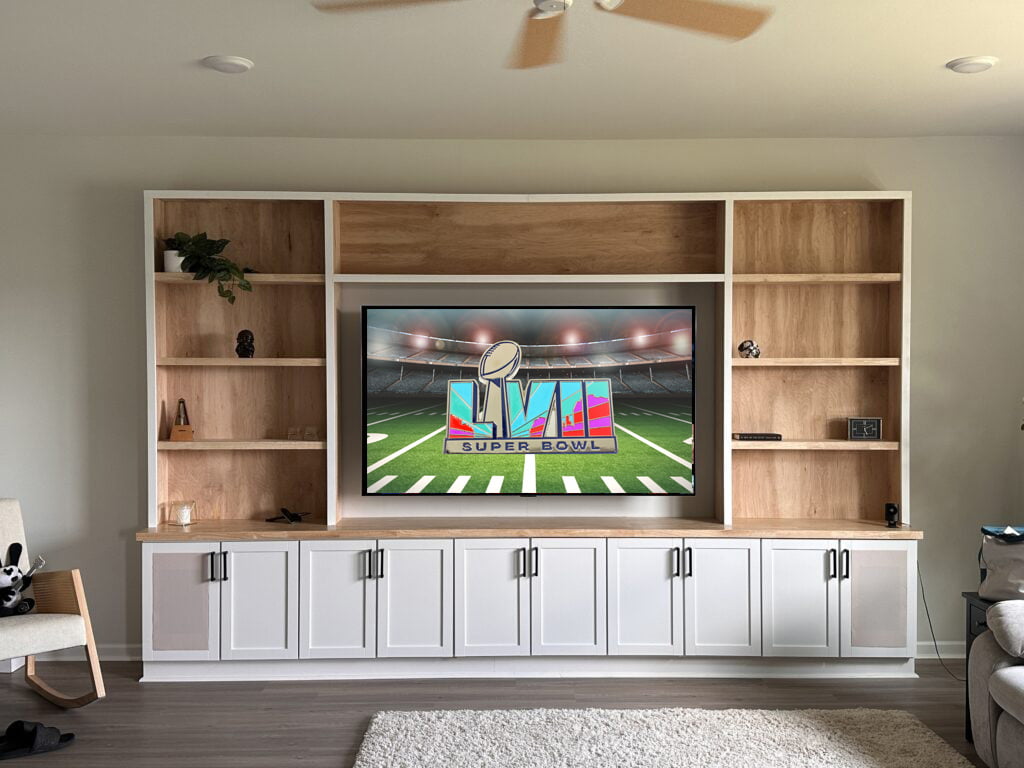
Evan Shepard/Gadget Review
We’ve redefined TV buying guides, setting us apart from any other site on the planet. Our unique approach combines in-house verification with a comprehensive dataset (150+ TVs) from trusted sites (200+), focusing on key testing metrics like response time, reflections, brightness, and viewing angle.
We aggregate and analyze this data, ensuring our recommendations meet the specific needs. In this case it’s for sports viewing, which means reducing or eliminating motion blur and reflections, overcoming bright lights and and offering wide audience viewing angles. Discover our data-driven methodology for precise, reliable TV recommendations.
You may notice some of our graphs contain “Source: RTings”. This is to indicate that the data we’re showing off in a graph has come from a single source – because it’s the only source that actually tested the criteria and had data for it! Normally, our data is an average out of all of the various publications that test and provide data to give you a good idea of how a product is going to perform on average.
Which Criteria Matter for Testing Sports TVs?
By focusing on these criteria (3 required, 3 nice to have), anyone can quickly and easily compare these TVs and how they perform when watching sports content. This helps you make an informed decision and purchase a TV that we can guarantee will deliver smooth action and crisp visuals to immerse you on game day.
| CRITERIA | RANGE | REQUIRED | DEFINITION |
|---|---|---|---|
| Response Time | <=10ms | Yes | Measures the amount of time it takes for a pixel to change from one color to another and then back. |
| SDR Brightness | 300+ nits | Yes | Measure of how luminous your screen is in SDR mode. |
| HDR Brightness | 700+ nits | Yes | Measure of how luminous your screen is in HDR mode. |
| Reflections | <= 4.5% | No (nice to have) | Measures what percent of light is reflected off the screen when subjected to light. |
| Color Gamut (DCI P3 xy) | >= 97% | No (nice to have) | Measure how much of a given spectrum of color can be reproduced by the TV. |
| Color Washout | > 45° | No (nice to have) | Measures the viewing angle on a TV before colors drop to 80% of the set’s chroma. |
Our Trusted Data Sources
(Publication category Score is 80%+)
We looked at 210+ TV reviewers and while 24 are trustworthy (60%+ Trust Rating), we only use data from the testers that are “very trusted” which means a Trust Rating above 70%. The three we have listed below are our most trusted for TVs, along with our own in-house TV expert.
- Evan Shepard – Gadget Review
- Matthew Lopes – RTings, MuckRack
- Will Greenwald – PCMag, MuckRack, Twitter
- David Katzmaier – CNET, MuckRack, Twitter
Interested in a comprehensive analysis of our data sources? We’ve got you covered. Below, you’ll find a detailed list of every TV review website we’ve identified, organized by their respective Trust Ratings from highest to lowest. But we didn’t stop there. We’ve meticulously reviewed each publication and verified the data by checking whether the authors have bio links to MuckRack or LinkedIn. We’re committed to not only checking the facts but ensuring their veracity.
TV Test Data & Results
1. Response Time TV Test Results
response time
1ms – 10ms
Acceptable range of performance
Definition: Speed at which a pixel transitions from one color to another.
Units of Measurement: ms (milliseconds)
Tools to Measure: Screen, camera, test software
Why It’s Important:
A faster response time means less blur and thus more accuracy.
Response time is particularly important for sports TVs due to the fast-paced nature of live sports events. Quick pixel transitions are necessary to accurately render the swift movements of players, balls, and other elements of the game without motion blur.
A lower response time ensures that these rapid movements are displayed clearly and sharply, enhancing the overall viewing experience by providing crisper, more fluid images.
This is essential for maintaining the integrity of the live action, allowing viewers to follow the game without losing detail or experiencing visual lag, which can detract from the excitement and immersion of watching sports.
Response Time (lower is better)
2. SDR & HDR Brightness TV Test Results
SDR brightness ensures that standard broadcast sports events appear clear and visible, even in well-lit rooms. HDR brightness, on the other hand, elevates the viewing experience by enhancing the contrast and vibrancy of colors in more modern, high-quality sports broadcasts.
In both cases, brightness directly impacts how bright the image being shown on the TV is, with higher brightnesses creating a more vivid picture that will generally look more appealing.
Generally speaking, SDR brightness values of 300 nits or higher, and HDR brightness values of 700 nits or higher make for a TV that will deliver an engaging experience for any kind of sport. Higher levels, however, are always welcome because they help enhance the vibrancy and contrast of the colors. For a user-friendly interface and clear visuals, also consider the best TVs for seniors, ensuring that everyone can enjoy the game.
Brightness
SDR: 300+ nits
HDR: 700+ nits
Acceptable range of performance
Definition: Maximum brightness in a specified pattern size window. Most commonly measured in a 10% or 100% white window.
Units of Measurement: nits (alternatively cd/m²)
Tools to Measure: TV, luminance meter
Why It’s Important:
Brightness helps counter ambient light so that details and colors don’t wash out and get lost.
SDR Brightness (in nits, higher is better)
HDR Brightness (in nits, higher is better)
3. Reflections TV Test Results
Reflections
<= 4.5%
Acceptable range of performance
Definition: How much light the TV screen reflects when subjected to light.
Units of Measurement: Percent of light reflected (%)
Tools to Measure: Spectrometer, Sampling Sphere
Why It’s Important:
Reflections can be distracting and distort the image.
Reflections handling on TVs is critical for sports fans, ensuring that glare from lights or windows doesn’t wash out the action. It’s about how well a TV can minimize the impact of ambient light on its screen, preserving the quality of the image during bright day games or well-lit room conditions.
Technically, this involves the TV’s screen surface and coatings designed to reduce the reflection of external light sources without affecting picture brightness and contrast. The effectiveness of reflections handling is often measured in percentage; the lower the percentage, the better the TV is at minimizing reflections.
Ideally, a TV reflects no more than 4.5% of light. TVs that boast advanced anti-reflective properties, such as matte screens, help to improve this capability.
Reflections (as a %; lower is better)
4. Color Gamut (DCI P3 xy) TV Test Results
Color gamut refers to the range of colors a TV can display, directly impacting how vibrant and lifelike the images appear. A wide color gamut means more vivid greens of the field, richer team colors, and a more immersive viewing experience that closely mimics being at the event.
Technically, color gamut is measured against standard color spaces, with DCI P3 xy being a common reference for high-definition content; covering more of the color space means the colors shown are more accurately reproduced.
For sports enthusiasts, seeking out a TV with a color gamut of 97% or higher on the DCI P3 xy scale means the action looks like it would there in the stadium. This criterion guarantees that the action on screen is as true to life as possible. And in case your vibrant TV screen encounters an unfortunate accident, knowing how to fix a broken TV screen can save you from the hassle of an expensive replacement.
Color Gamut
>= 97%
Acceptable range of performance
Definition: The TV’s capability to display a spectrum of colors.
Units of Measurement: % (color space coverage in percent)
Tools to Measure: Colorimeter
Why It’s Important:
Inaccurate colors compromise the authenticity of the content.
DCI P3 XY Color Gamut (as a %; high is better)
5. Viewing Angle (Color Washout) TV Test Results
Viewing angle
> 45°
Acceptable range of performance
Definition: The angle at which color washout begins to impact image accuracy.
Units of Measurement: Angle in degrees
Tools to Measure: Colorimeter
Why It’s Important:
If a large group is watching on game day, a wide viewing angle will help ensure everyone can view the content.
Bad view angles during a big game can sideline your viewing experience. Imagine everyone crammed in, but only those front and center get the vivid, action-packed view. It’s crucial for the whole crew to catch every play in complete clarity, no matter their spot in the room. To ensure everyone in the room has the best view possible, also consider learning about how high your TV should be mounted for the optimal viewing experience.
Think of viewing angle as how far you can move from the middle before the screen starts to fade and lose its punch. You want a TV that keeps the game’s color and , from any angle.
Ideally aim for a TV with a 45-degree minimum for a wide viewing angle. This is the sweet spot ensuring the game stays sharp and vibrant. And for an even more immersive experience that mimics stadium viewing, explore the best curved TVs, which offer superior viewing angles.
Viewing Angle (as degrees; higher is better)
Data Source: rtings.com
Sports TVs: Mistakes To Avoid
- Ignoring Refresh Rate: A TV with a low refresh rate can result in motion blur during fast-paced scenes common in sports. Look for a TV with at least a 120 Hz refresh rate to ensure smoother motion. This is also crucial when considering the best gaming TVs, as it ensures clarity and responsiveness during intense gaming sessions.
- Neglecting Viewing Angles: Especially for group viewings like sports events, wide viewing angles are important. OLED TVs typically offer better viewing angles than LCD/LED TVs, ensuring the picture remains consistent from different seating positions.
- Compromising on Brightness and Contrast: TVs with poor brightness levels or contrast ratios might not deliver the vivid and dynamic images needed to truly appreciate sports. HDR support can significantly improve contrast and color range.
- Skipping Over Size and Resolution: Choosing a TV that’s too small for your viewing distance or one with low resolution can hinder your ability to catch all the action details. Ensure the TV is large enough and has a high resolution, such as the top-rated 4K TVs (4K is standard now). For those looking to future-proof their setup or desire even more detail, exploring the best 8K TVs can be worthwhile. Understanding the difference between 4K vs 8K is important, as 8K offers even more detail and clarity but requires suitable content to fully appreciate its advantages
- Not Considering the Room’s Lighting Conditions: A TV that performs well in a dark room might not do as well in a brightly lit room, and vice versa. Reflective screens can be problematic in bright rooms, so consider your room’s lighting and choose a TV with appropriate anti-glare properties.
- Overlooking Connectivity Options: Ensure the TV has enough HDMI ports for all your devices, like cable boxes, game consoles, and streaming devices. Smart TVs can also access sports streaming services directly, which can be a plus. Additionally, if you want to improve the audio quality of your TV, you will need to make sure you have enough of the correct ports when connecting a soundbar to it.
The Best Sports TV Tests Compared
Product |
True Score
|
Response Time
|
SDR Brightness
|
HDR Brightness
|
Reflections
|
Color Gamut
|
Viewing Angle
| |
|---|---|---|---|---|---|---|---|---|
| 92 |
|
|
|
|
|
| $999.99 $1,500 $500 |
| 91 |
|
|
|
|
|
| $1,996.99 $3,297 $1 |
| 89 |
|
|
|
|
|
| $1,899.99 $2,300 $400 |
| 88 |
|
|
|
|
|
| $1,299.99 $1,600 $300 |
| 86 |
|
|
|
|
|
| $949.99 $1,000 $50 |

